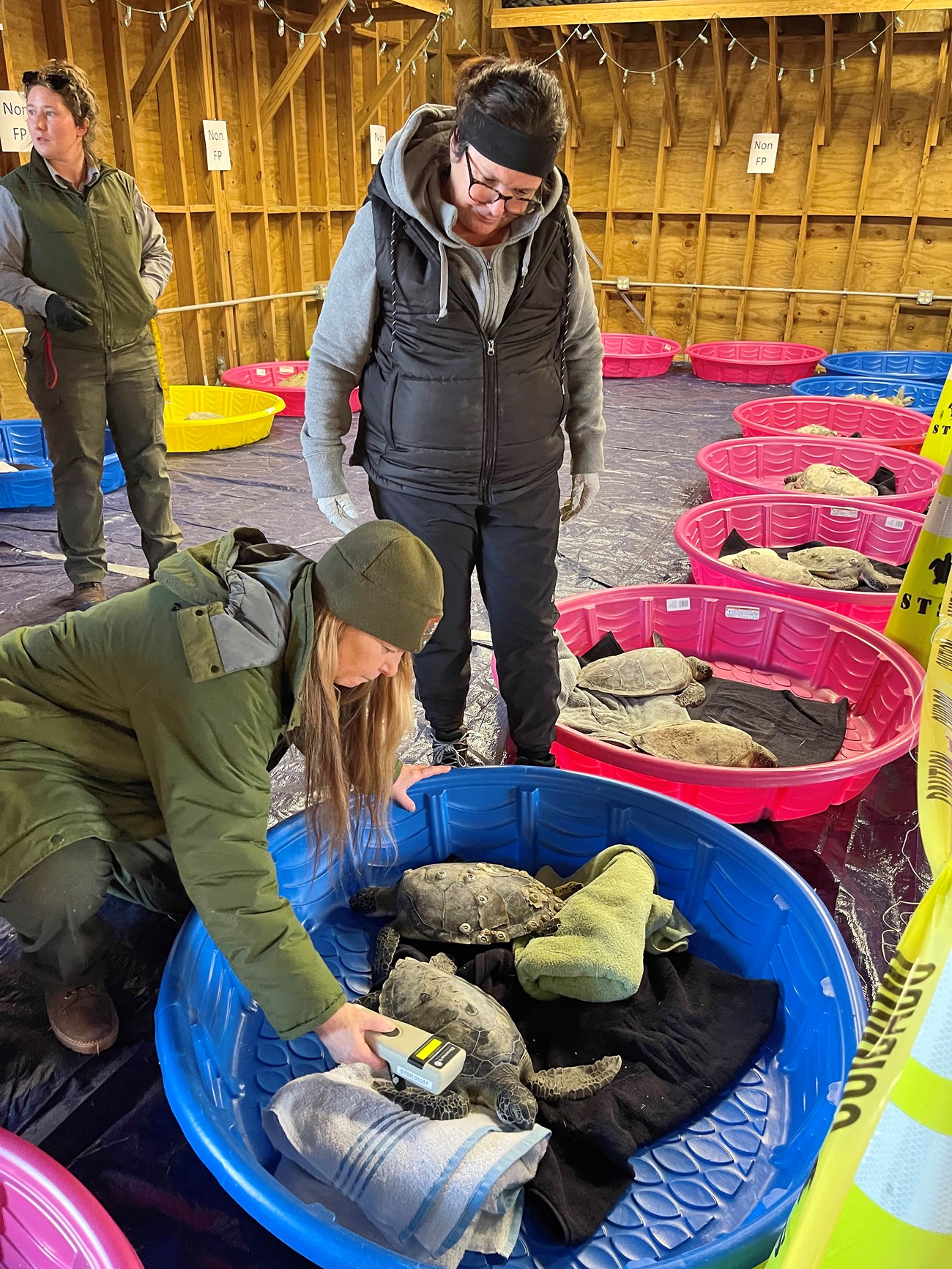Last updated: August 31, 2024
Article
Significant Sea Turtle Cold-Stunning Event Tied to Climate Change Impacts on the Texas Coast
In February 2021, an extreme cold front swept the south Texas coast, rendering tens of thousands of endangered sea turtles lethargic and helpless. Working against the clock, a dedicated team of rescuers rushed to save them. A new study indicates long-term impacts.
By Donna J. Shaver and J. Shelby Walker

Image credit: NPS
Bracing for yet another influx of “unprecedented” cold winter weather, employees and volunteers with Padre Island National Seashore’s sea turtle program don layers of clothing and retrieve netted poles as they head out to walk the shoreline. All sea turtles found in U.S. waters are protected under the Endangered Species Act. But sudden water temperature drops can trap them in shallow bays and stun them, allowing wind to push them onto the shore. The lethargy induced by the colder water makes them vulnerable to being struck by boats or killed by predators. Although climate change is causing warmer average temperatures worldwide, it’s also implicated in an increase in wintertime extreme cold-weather events like these. This has devastating effects on Padre Island’s sea turtles, which seashore staff and volunteers must work tirelessly to rescue if the turtles are to survive. Current park research reveals that green turtle numbers decline after such events.
Vulnerable to Cold Weather Extremes
Sea turtles are ectothermic, meaning they cannot regulate their body temperature metabolically or by increasing their activity, as people and other “warm-blooded” animals do. Instead, they depend on external heat sources—like warm water or sunshine—to maintain an optimal body temperature. For this reason, they are vulnerable to sudden temperature changes, particularly in shallow waters like the Laguna Madre, a salty lagoon bordering the national seashore. This lagoon is one of the most important habitats for juvenile green sea turtles in the western Gulf of Mexico. Because it is so shallow—only about four feet deep on average—water temperatures there can drop quickly.
It was the largest sea turtle stranding event ever recorded worldwide.
During a severe cold front in February 2021, National Oceanic and Atmospheric Administration Sea Turtle Stranding and Salvage Network partners documented 13,326 cold-stunned green turtles in Texas. Although it’s difficult to determine the exact population size for a mobile species like the green sea turtle, the seashore’s turtle team estimates this event likely affected all green sea turtles in Texas inshore waters. According to internal park data, this was more than triple the number of cold-stunned turtles found during winter 2017–2018, the previous largest event in Texas. It was nearly three times as large as the previous largest event in the entire U.S. (which happened in Florida) and was the largest sea turtle stranding event ever recorded worldwide.

Image credit: NPS
Today, park scientists believe cold stunning is the greatest cause of green sea turtle strandings and mortality in Texas. Some turtles that experience sudden drops in temperature can initially have milder injuries like non-lethal water inhalation and immune impairments. But if not rescued and transported to rehabilitation,these individuals may be more susceptible to predation and may not survive the months it will take them to recover. A recent internal park analysis indicates that green turtle numbers decrease in the years following large, lethal cold-stunning events. This suggests that these extreme events cause population-level impacts on survival.
Protecting What’s Left
In the U.S., there are six species of sea turtles (green, hawksbill, Kemp’s ridley, leatherback, loggerhead and olive ridley) which are listed as either endangered or threatened under the Endangered Species Act. Phillippe Tissot is a co-principal investigator for the National Science Foundation Artificial Intelligence Institute for Research on Trustworthy AI in Weather, Climate, and Coastal Oceanography. “We are only starting to experience the impacts of climate change,” he said. “Sea turtles are wonderful sentinel species. Climate change-ready programs, such as the one [at Padre Island National Seashore] will be critical to species recovery.”

Image credit: NPS
At Padre Island National Seashore, park staff, volunteers, and partners devote hundreds to thousands of hours every year monitoring, rescuing, and releasing cold-stunned green sea turtles. It’s a grueling but necessary task to save this ancient and imperiled species. The goal of the seashore’s turtle patrols, conducted when the air and water temperatures drop, is to encounter live turtles and save them before they succumb to exposure and cold. These first responders are usually able to find turtles while they’re still alive. In 2022, for example, there was a relatively small cold-stunning event, where 97 percent of the 436 turtles rescuers encountered were still living.
Scientists have linked these extreme cold events to Arctic warming, which drives polar vortices into the mid-latitudes of North America.
But the number of cold-stunned turtles during 2021’s record-breaking weather event was so great that responders were only able to find 32 percent alive. The seashore and its partners didn’t have enough people, time, and resources (such as boats) to rescue that many turtles before they died from exposure or predation. Scientists have linked these extreme cold events to Arctic warming, which drives polar vortices into the mid-latitudes of North America. As climate change causes increasingly extreme weather, we’ll likely see more such devastating impacts.
People may wonder why sea turtles should be saved from a natural weather event. There are many reasons to give. But it’s important to realize that the green sea turtle might not be in danger of extinction in the first place were it not for people’s actions. Green turtles were captured and harvested nearly to extinction in south Texas from the mid-1800s to 1900. When the numbers of turtles were already severely reduced, extreme cold weather events in 1894 and 1899 caused many more turtles to die. Green turtle numbers have rebounded in Texas in recent years. But worldwide, there are far fewer than there were historically. The actions of the past aren’t always easy to reverse without dedicated efforts to protect what is left.
Here Since the Time of the Dinosaurs
Sea turtles have existed since the age of the dinosaurs, but pressures from things like disease and loss of habitat from human development threaten their continued existence. Now they’re suffering a one-two punch from climate change. As temperatures increase globally, the shallow waters that juvenile sea turtles inhabit stay warmer for longer periods during the year. Consequently, their winter migration to deeper, warmer water is delayed. Delayed migration combined with increasingly severe winter storm events create a deadly combination for the turtles, who become trapped in deceptively warm areas when severe cold fronts pass through, rapidly cooling the shallow water.

Image credit: NPS
Rising global temperatures resulting in warmer beaches could also affect these ancient species in other ways. All sea turtles have an optimal egg incubation temperature range. And the sex of sea turtle hatchlings depends on the warmth of the sand in which their mothers buried the eggs. Warmer conditions result in more female hatchlings, sometimes to the exclusion of males. And sand temperatures that are too hot are lethal to the embryos, resulting in fewer or no hatchlings.
Padre Island National Seashore’s dedicated responders and partners are doing their best to hold the line.
The road to recovery for cold-stunned green turtles in Texas is relatively swift for those animals found and rehabilitated quickly. But if injured by predators or boat strikes, or through partial drowning in seawater in their lethargic state, they require extensive long-term care. In Texas, many of these sea turtles are rescued through community support and aid from agencies and nonprofit organizations. The park and its local partners have also hosted public releases of rehabilitated turtles, which helps foster support for this work. Padre Island National Seashore’s dedicated responders and partners are doing their best to hold the line as extreme weather wrought by climate change tests the resilience of these charismatic reptiles. It’s not a job for the faint of heart.


Jennifer Shelby Walker is a biological technician with the Division of Sea Turtle Science and Recovery at Padre Island National Seashore. Image credit: NPS
